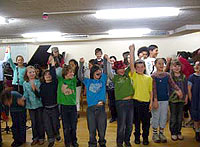English
 |
【日本語|English】 【No.1|No.2|No.3|No.4|No.5|No.6】 |
No.4 Making story and music from your imagination! 'World In Motion'
 |
The other activity held in the Easter holidays was 'World In Motion'. How did it go with different leaders and different participants? |
|
- - Avtivity Information - -
■Title: World In Motion
■Dates: 16-20 Feb 2009 (Latin theme), 14-16 Apr (UK sounds), 25-29 May (African beats) ■Leader: Detta Danford (flute), Natasha Zielazinski (cello), Maxwell Golden (guest) ■Target: 8-14 years old ■Fee: Free |

The leaders of this workshop 'World In Motion' were Detta and Natasha. These two have both completed their master's course in Leadership at the Guildhall last summer and started their careers as professional workshop leaders. This spring, they had three 'World In Motion' activities: Latin theme in February, UK sounds in April, African beat in May. Each time they had a different guest leader. This time, they led the workshop with a guest leader Maxwell, who is active as a poet, a musician, and a workshop leader.

The participants in 'World In Motion' were generally younger than those in 'Urban Sounds'. They were around primary and lower secondary school age. The ensemble consisted of about 30 young people, 3 students and 3 leaders: 5 violins, 4 flutes, 4 cellos, 1 viola, 2 drums, 2 classic guitars, 4 clarinets, 2 saxophones, 1 jembe, 3 pianos, and 3 vocals. Children around these ages are especially full of energy and have big differences in terms of the maturity of their bodies and souls, technical ability and musical experience. How do they cope with this large number of pupils with a lot of variety, and create one piece of music?
 
|
On the morning of the first day, they spent a lot of time on warm-up activities. Maxwell took the leading role and relaxed the bodies and minds of the children, who were still shy about meeting a lot of new people. At first, they made a big circle and introduced their names with any movement they liked, and then everyone else repeated the name, copying its movement, tone and rhythm. In other activities, they continuously counted one to three in pairs, and then changed '2' to some noise with an action that they thought up and continued counting. At last, they created their unique 1,2,3, and these three beats ran between the two. Even the simple warm-up activities and games had some musical elements, such as thinking of a unique expression on the spot and expressing themselves, and listening to other members' ideas carefully and reproducing the sounds and rhythms of them.
 
|
The activities in the small groups gradually became bigger. In the one named 'Producer-Sampler', a producer=composer thought of a short phrase and told the idea to the sampler next to him/her. While the sampler kept singing the first phrase, the producer were told by the next producer his/her idea and reproduced it as the second sampler, and sang along with the first sampler. Continuing it in a group of 30, the phrase got rhythm, bass, and many layers of melodies. At last, they created an ensemble in which 30 people were singing 30 different phrases that could be heard only there and once.

(Guest leader)
'Through a lot of activities, I want them to feel that, if you want to create something good together, you have to realize that the supporting role is as important as the leading role,' Maxwell said, 'When someone else is playing, they are more likely to succeed if you focus on and put your energy into it. The sound of an ensemble works only if its elements support each other well'. In fact, they were listening to the sound carefully, imagining what it would be like when they added their ideas to the music, and jumped into it.

After playing outside in the lunch break, they sat in a circle and created a story with all of the participants. When someone said a sentence, such as, 'There was a little pond', when you liked it, you'd say 'Yes! and..' and added another sentence to it, and kept going.  When you didn't like the story, you could say 'No', then another story would be suggested. Because it was told by many individuals with a lot of different characters, the story sometimes developed in ways they didn't imagine, so the children were very curious about how it went. Finally, they got a story: A boy went to a mental hospital, and then he joined a party, where he got a rabbit. Chasing after the rabbit, he fell into a pond and met a mermaid in a cave, but that mermaid was evil and he was rescued from the other mermaid and fell in love.
When you didn't like the story, you could say 'No', then another story would be suggested. Because it was told by many individuals with a lot of different characters, the story sometimes developed in ways they didn't imagine, so the children were very curious about how it went. Finally, they got a story: A boy went to a mental hospital, and then he joined a party, where he got a rabbit. Chasing after the rabbit, he fell into a pond and met a mermaid in a cave, but that mermaid was evil and he was rescued from the other mermaid and fell in love.
 
|
The leaders divided the story into several scenes and created several groups. Each group was in charge of one scene, and turned the story into music. In one group, whose scene was about 'escaping from the cave', a girl with a stringed instrument suggested, 'how about sliding our fingers on a string gradually upwards and then sliding down quickly to express trying to climb the wall and then falling?' Then, a boy pianist followed the idea and suggested that he could make a jump from high keys to very low keys on the keyboard. Many suggestions were made in another group as well. 'Would you like the idea of playing repeated notes on the clarinets and a sax and making it fast like heart beats?' 'I like that! How's this note?'
As it was not the story they were given, but it was a story they created on their own, imagining the scene, wondering how it would it be next, being surprised by others' ideas, they shared the image and feelings of the story with each other, so they could convey their idea equally with confidence. We could see how they had the image clearly by listening to the music they created, which had not only melodies and rhythms but also 'tension', 'excitement', 'relief', 'affection', and these were expressed vividly.
  Natasha (Leader)

|
On the second day, every group's idea was brought in together, and was arranged and formed into a big musical piece being led by Detta and Natasha. The lyrics and the music of the love song with the mermaid and for the opening scene were added to them. On the last day, they went over the music, the lyrics and the structure, and then they got a stage plan for the opening scene, and they practiced it to show to their families when they came to pick them up. The opening scene began as all of the children came in to the empty stage singing 'every day is the same...' and wandering around the stage as if they were in a mental hospital. When they reached their position, it suddenly turned into a party scene! Every piece of music that they created came together to make a 20-minute-long massive piece, with some solos, and, at the end, they came forward on the stage singing. Their faces were smiling, shining with satisfaction and confidence about performing their music in front of their families.
'It was very impressive that they helped each other quite naturally, even if we didn't tell them to,' Natasha said. 'The age difference didn't matter. I saw a younger girl helping the older girls who were not here yesterday. And I was really amazed that, when a vocal solo part couldn't finish the lyric at the time at which it was supposed to finish in the final concert, everyone was watching and waiting for the singer to finish, and jumped into the music at the same time.'

'It was the first time for us to try this kind of story-and-music making process. It was very exciting for us too,' Detta said, 'We sometimes make music and lyrics, but this one had a different effect on us that everyone shared the same concept and make music alongside that'.
Maxwell added, 'They had not only the ego to play their own section but also had the sense that they were part of the whole music and they tried to express the shared image and the feelings of the story. I've been working with many workshops in such genres as poems, acting and Hip Hop music. It is different in the way they express themselves and the products they make, but the idea and the process have much in common, and the collaborations produce a lot of energy. I hope we can make much more collaborations in the future.'

(Leadership student)
There was a student violinist, Eiko Azuma, who came from Kobe College in Japan, in this programme. She had been impressed when she experienced the workshop led by Mr. Gregory when he visited Japan, and came to study on the Leadership course at the Guildhall last autumn. 'Just as the children would feel, I got a happy impact that 'my idea has become music!' , and that made me come here,' Eiko said.

Most of the programmes on the course were practical. 'For me, who only had learnt violin in the classical pathway, the way they developed musical material freely with all kinds of musical languages, styles and improvisation, and turned it into a piece of music that we had never heard, was sensational. It was quite new to me.' She found out many things as she learned in practice. 'The first ten minutes are important. We have to create an environment in which children feel free to show what they have. It is also important to look at children carefully and seize what they want to do and what they can do, and to accept everything children throw out and respond to it. We need to think a lot at the same time, such as whether to use this boy's idea in the music now or later, and how.'

'Most Japanese children are shy, so I don't know whether the same procedure works for them as in the UK, but I believe that we can find the way that fits for the Japanese. I think creativity is not only about making music, but also about the ability to have ideas of how we deal with things and develop them. Without it, even if we input what is in the textbook, we cannot make the most of it. Also, I think it is a good opportunity to challenge their limits. Japanese children tend to set limits on what they can do. They might be able to do more if they try. Then they need the strength to break the shell from inside, not waiting to be broken from the outside - it is creativity. I think music and art have the power to develop that strength. One of my goals is to convey it.'
Next, we will see how it will be at the final concert!
Report: Chigusa Futako








